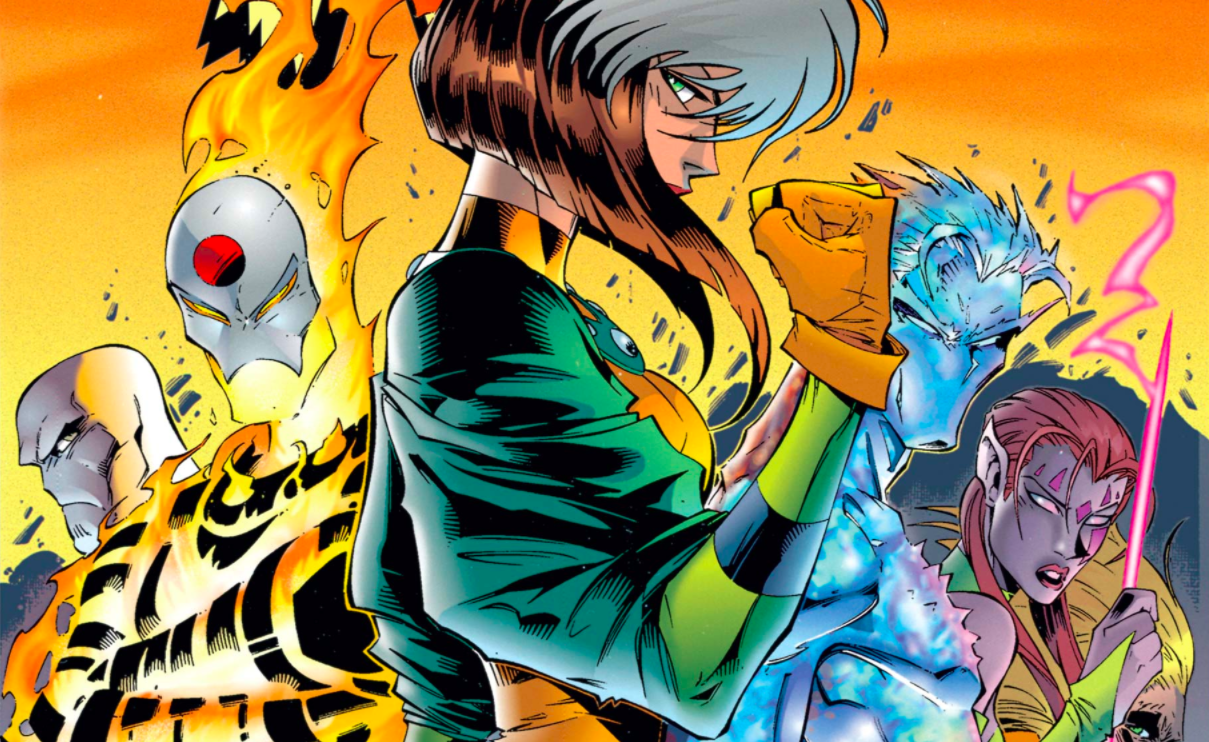No Exit
"Once More, With Feeling" / "No Exit" / "In Excess" / "Holocaust!"
Astonishing X-Men #1-4 [1995]
Written by Scott Lobdell
Pencils by Joe Madureira
Inks by Tim Townshend, Dan Green, and Al Milgrom
"Age of Apocalypse" is a fun story and fan experience, but when I look at those issues now I mostly see a formal experiment that went very, very well. The creators who worked on the book – basically a small army led by X-Men lead writers Scott Lobdell and Fabian Nicieza – were all recent inheritors of the X-Men franchise, which was still very much defined by Chris Claremont's 17-year run on Uncanny X-Men. Those creators were all fans who'd lucked into running the show after Jim Lee, Rob Liefeld, and Whilce Portacio bailed on Marvel to form Image Comics in 1992, and mostly seemed to be doing their best to please fans of their predecessors through 1994. “Age of Apocalypse” wasn't just a sales stunt event, but an opportunity for all these writers and artists to flex and do something totally new that was an expression of their creativity rather than merely their adaptability.
The premise of the "Age of Apocalypse" is that the reader is tossed into a totally different X-world in which Charles Xavier died before founding the X-Men and the X-Men are instead led by Magneto on a planet which has been largely conquered by a despotic Apocalypse. The writers took this opportunity to radically reinterpret the franchise as a way of putting ironic twists on familiar characters – Beast and Cyclops are now baddies, Sabretooth is now a hero – but to build on then-recent narrative themes such as Nightcrawler discovering that his mother is Mystique or Iceman realizing that his low self-esteem has led him to not fully explore the possibilities of his powers. Nicieza took his X-Men book as an opportunity to add some details to Exodus, a major villain who was entirely vague at that moment, and Lobdell explored Sunfire, the temperamental Japanese X-Man who quit almost immediately after joining the team in Giant Size X-Men #1 and only appeared occasionally since. The plot of “Age of Apocalypse” is fine enough, but in the moment and to this day, the real thrill of it was in seeing the results of the creators going wild with the source material.
Astonishing X-Men has always been my favorite of the "Age of Apocalypse" mini-series, largely because it's illustrated by Joe Madureira just as he was hitting his stride. Madureira, only 20 years old at the time, is the definitive AOA artist and is responsible for the majority of the most memorable designs used in the event. In this series we get Sunfire, radically transformed into a being of living flame with a mask and bits of black armor to give definition to the contours of his body. There's Blink, a character he'd designed for the previous year's “Phalanx Covenant” event, remade from a cowardly young girl into a confident and heroic figure playing the Kitty Pryde/Jubilee ingenue role in this squad of X-Men. Madureira's most startling design is for the newly created villain Holocaust, who is basically a burning skeleton locked inside a hulking battle suit entirely comprised of clear armor.
Whereas the other artists drawing issues of the "Age of Apocalypse" event were working in the general stylistic milieu of Lee and Liefeld, Madureira's clean, cartoony line and dynamic storytelling style was more like Paul Smith channeled through the aesthetics of Japanese animation. Madureira's work here would turn out to be as influential and transformative as Arthur Adams and Jim Lee before him, and was crucial in establishing a new style for X-Men that was not based in emulating departed talent.
By the time Lobdell had started on Astonishing X-Men he'd had plenty of practice in writing ensemble casts, and in this mini-series he was showing off how naturally the rhythm of it all came to him while establishing a lot of world building. He fills out the tragic backstory of this Sunfire, establishes this version of Sabretooth as a rough equivalent of Wolverine totally at odds with the irredeemable monster he was writing in proper continuity as if to provoke a nature vs nurture argument, and makes Blink so cool and fun that Marvel editorial would have to go out of its way to create the dimension-hopping Exiles series as a way of bending the rules of continuity to satisfy fan demand given that the "real" version was killed off shortly after being introduced. The relationship between Sabretooth and Blink is particularly powerful, echoing the surrogate father/daughter dynamic of Wolverine and Jubilee but more poignant given the dystopian backdrop of the story. (It's worth noting that Lobdell and Nicieza very obviously patterned their regular continuity version of Sabretooth on Hannibal Lecter, so giving Blink the name Clarice has an interesting charge to it.)
Lobdell's cast of Astonishing X-Men is so different from the one that he was writing in Uncanny X-Men that the only character in both casts is Rogue, and this version of Rogue is a very different person. This Rogue is married to Magneto and co-leader of the X-Men, and carries herself with a gravitas far different from the loose cannon energy of her regular continuity counterpart. The most intriguing AOA versions of characters answer the question of "what if this X-Man had a totally different life?" in ways that invert what we know about them in compelling ways – a sullen Nightcrawler without Catholic dogma, a demented and sadistic Beast, or a smug and immensely powerful Iceman. Seeing those characters without constraints is a revelation, whereas Rogue without the burdens of her power or having to live down bad decisions of her past just makes her come across like a generic superhero.



